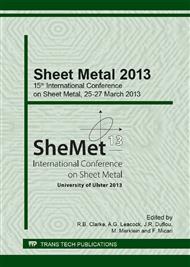p.117
p.125
p.133
p.141
p.149
p.156
p.164
p.172
p.180
Robot-Based Incremental Sheet Metal Forming – Increasing the Geometrical Complexity and Accuracy
Abstract:
The industrial application of incremental sheet metal forming is still limited by certain constraints, e.g. low geometrical accuracy and geometrical complexity. In order to overcome these constraints, this paper presents two approaches which have been carried out within the research project Development of a robot-based dieless incremental sheet metal forming process funded by the German Research Foundation (DFG). The first approach increases the geometrical accuracy by adding an addendum stabilization surface. As neither a partial nor a full die is used in this universal concept, there is a larger influence of the free compliant sheet area surrounding the formed part of the geometry. Thus the sheet shifts away from the forming tool more easily, which often results in a less accurate forming. The addendum stabilization surface reinforces this free sheet area. Experiments have proven this to be as good as a partial die. Especially the subsequent deformation resulting from the interaction of differently shaped elements causes geometrical deviations which are limiting the scope of formable parts. The second approach is based on the subsequent forming of elements belonging to the original geometry, which helps to increase the geometrical accuracy as well as the geometrical complexity. Thus the basic geometry is formed in a first step. Afterwards, further elements are formed subsequently, while the adjacent areas are supported by a peripheral supporting tool which prevents their deformation.
Info:
Periodical:
Pages:
149-155
Citation:
Online since:
April 2013
Authors:
Keywords:
Price:
Сopyright:
© 2013 Trans Tech Publications Ltd. All Rights Reserved
Share:
Citation:


